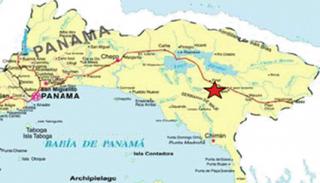Piriati Arriba, Panama
![]()
![]()
![]()
![]()
![]()
![]()
![]() Click on Programs to learn more about their work in this community
Click on Programs to learn more about their work in this community
General Information

| Population* | 100 |
| Number of homes | 35-40 |
| Avg # of people per home | 2-3 |
| Electricity | None |
| Corregimiento | Torti |
| District | Chepo |
| Corresponding Health Center | Centro de Salud - Torti |
| Distance from compounds | N/A |
| Road conditions | Good (about 15-20 minutes of dirt road) |
* Population does not reflect how many patients will be seen on medical
brigades as many people from surrounding communities come seeking
Medical Brigades medical attention.
Expressed Needs and Capacities
Piriati Arriba is a latino community in the eastern region of the Panama province. Needs expressed by the community include roads or bridges to cross the rivers in order to get to the community, latrines, and electricity. One feature unique to this small community is that the community is relatively spread out – the average distance between houses is 15-20 minutes. Because of this, and the expressed lack of a strong community leader, community members have indicated that it is difficult to motivate the community to work together.
Piriati Arriba has a primary school for grades 1-6 located in the center of the community. Children in this community must travel to Piriati Embera (about 45 minutes walking) to attend secondary school. Currently there are only 4 students from Piriati Arriba attending secondary school in the community of Piriati Embera. Approximately 95 percent of the community members of Piriati Arriba are literate.
Piriati Arriba is currently connected to a gravity-based water system that was constructed in 2008 and is connected to approximately 87% of the homes in the community. Families connected to this system must pay $1 a month to be connected to this water system. The community has expressed that they have more problems with water during the rainy season and that the piping and the water pressure need improvement. The water source that supplies this system is located 3.5 hour from the community and the storage tank is located within the community. During the dry season, community members typically have water everyday, but during the rainy season, only 3-4 days a week. In the past the water has been treated with chlorine to combat harmful bacteria and parasites, but currently there is no one responsible for chlorinating the water in this community.
Piriati Arriba does not have a health center or health post located within their community. The nearest health center to this community is located in the town of Torti (approximately 50 minute drive). Torti also represent the closest access to dental care. There are currently no medical professionals living in the community and they have not formed a health committee. The most common illnesses in this community are colds, diarrhea & vomiting, and parasites. 50% of the community has latrines, and only 2% of the community has cement floors in their home.
The average monthly income in Piriati Arriba is $50-120 per month, with the average monthly expenses being $150-$200. The main form of work for members in this community is agriculture – coffee, lentils/beans, corn, plantains, yams rice, pineapple, and mango. Members of the community do not currently have access to credit because they do not hold titles for their land.
Currently, the most common practice for waste management within Piriati Arriba is the burning of trash. Members of this community do not practice recycling and there are no current reforestation projects being implemented.
The members of this community do not currently have access to legal services. These services can be accessed in the town of Chepo (approximately 1 hour in public transport). Community members have described that family conflicts and land issues are present in the community but the overall sentiment is that they do not see the need for access to legal services.
The community follows the general administrative government structure of Panama.
Medical and Dental are currently the only programs working with this community.